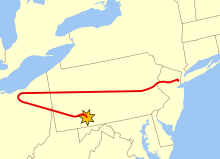 UA 93's flight path from Newark, New Jersey, to Stonycreek Township, Pennsylvania | |
| Suicide hijacking | |
|---|---|
| Date | September 11, 2001 |
| Summary | Terrorist suicide hijacking, crashed as a result of a passenger revolt in response to the earlier 9/11 attacks. |
| Site | Field (Flight 93 National Memorial) near the Diamond T. Mine, a coal strip mine in Stonycreek Township, Pennsylvania, U.S. 40°03′02.8″N 78°54′17.3″W / 40.050778°N 78.904806°W |
| Aircraft | |
| Aircraft type | Boeing 757-222[a] |
| Operator | United Airlines |
| IATA flight No. | UA93 |
| ICAO flight No. | UAL93 |
| Call sign | UNITED 93 |
| Registration | N591UA |
| Flight origin | Newark Int'l. Airport (now called Newark Liberty Int'l. Airport) |
| Destination | San Francisco Int'l. Airport |
| Occupants | 44 (including 4 hijackers) |
| Passengers | 37 (including 4 hijackers) |
| Crew | 7 |
| Fatalities | 44 (including 4 hijackers) |
| Survivors | 0 |
United Airlines Flight 93 was a domestic scheduled passenger flight that was hijacked by four al-Qaeda terrorists on the morning of September 11, 2001, as part of the September 11 attacks. The hijackers planned to crash the plane into a federal government building in the national capital of Washington, D.C. The mission became a partial failure when the passengers fought back, forcing the terrorists to crash the plane in Somerset County, Pennsylvania, preventing them from reaching al-Qaeda's intended target, but killing everyone aboard the flight. The airliner involved, a Boeing 757-200 with 44 passengers and crew, was flying United Airlines' daily scheduled morning flight from Newark International Airport in New Jersey to San Francisco International Airport in California, making it the only plane hijacked that day not to be a Los Angeles–bound flight.
Forty-six minutes into the flight, the hijackers murdered one passenger, stormed the cockpit, and struggled with the pilots as controllers on the ground listened in. Ziad Jarrah, who had trained as a pilot, took control of the aircraft and diverted it back toward the East Coast, in the direction of D.C. Khalid Sheikh Mohammed and Ramzi bin al-Shibh, considered principal instigators of the attacks, have claimed that the intended target was the U.S. Capitol Building.[1]
The plane was 42 minutes behind schedule when it left the runway at 08:42. The hijackers' decision to wait an additional 46 minutes to launch their assault meant that the people being held hostage on the flight very quickly learned that suicide attacks had already been made by hijacked airliners on the Twin Towers of the World Trade Center complex in New York City as well as the Pentagon in Arlington County, Virginia, near D.C. By 9:57 a.m., only 29 minutes after the plane had been hijacked, the passengers had made the decision to fight back in an effort to gain control of the aircraft. In the ensuing struggle, the plane nosedived into a field near a reclaimed strip mine in Stonycreek Township, near Indian Lake and Shanksville, about 65 miles (105 km) southeast of Pittsburgh and 130 miles (210 km) northwest of the capital. One person witnessed the impact from the ground, and news agencies began reporting the event within an hour.
United Airlines Flight 93 was the fourth and final passenger jet to be commandeered by terrorists on September 11, and the only one that did not reach a target intended by al-Qaeda. The hijacking was supposed to be coordinated with that of American Airlines Flight 77, which struck the Pentagon less than 26 minutes before the crash of Flight 93. A temporary memorial was built near the crash site soon after the attacks.[2] Construction of a permanent Flight 93 National Memorial was dedicated on September 10, 2011,[3] and a concrete and glass visitor center (situated on a hill overlooking the site)[4] was opened exactly four years later.[5]
Cite error: There are <ref group=lower-alpha> tags or {{efn}} templates on this page, but the references will not show without a {{reflist|group=lower-alpha}} template or {{notelist}} template (see the help page).
- ^ Cite error: The named reference
Foudawas invoked but never defined (see the help page). - ^ "Flight 93 National Memorial – 2007 brochure" (PDF). National Park Service. December 2007. Archived (PDF) from the original on May 14, 2009. Retrieved February 6, 2017.
a temporary memorial was created on a hilltop overlooking the crash site.
- ^ "Flight 93 National Memorial – Sources and Detailed Information". National Park Service. n.d. Archived from the original on March 30, 2015. Retrieved January 31, 2017.
13. When will the Memorial be finished?
- ^ "Flight 93 National Memorial – Frequently Asked Questions (FAQs)" (PDF). National Park Service. May 2013. pp. 22–23. Archived (PDF) from the original on July 15, 2013. Retrieved January 31, 2017.
- ^ "A Long Road to a Place of Peace for Flight 93 Families". The New York Times. September 9, 2015. Archived from the original on August 4, 2017. Retrieved September 9, 2015.